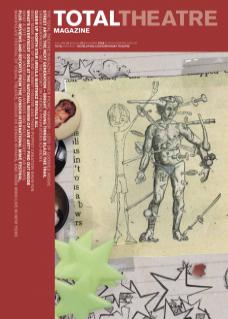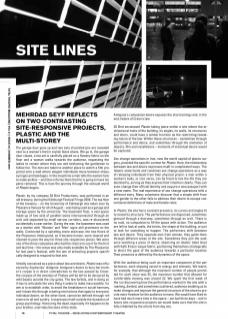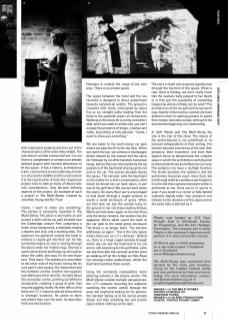The garage door goes up and two sets of pickled jars are revealed next to a woman’s feet in stylish black shoes. We go in, the garage door closes, a tea set is carefully placed on a flowery fabric on the floor and a woman walks towards the audience, requesting the ladies to remain where they are and beckoning the gentlemen to follow her. The men are taken to another place to watch a film projected onto a wall where elegant individuals move between shoes, syringes and bandages. In the meantime a man tells the women how to make pickles – and then informs them that he is going to have his penis removed. This is how the journey through the sensual world of Plastic begins.
Plastic, by my company 30 Bird Productions, was performed in an old brewery, during the Edinburgh Festival Fringe 2008. The top floor of the brewery – on the University of Edinburgh site taken over by Pleasance Venues for all of August – was being used as a garage and storage space by the university. The basement floor, a vast space made up of two sets of parallel rooms interconnected through an arch and separated by small narrow corridors, was rediscovered accidentally a year earlier. During the war, the basement was used as a shelter with ‘Women’ and ‘Men’ signs still prominent on the walls. Connected by a spiralling stone staircase, the two floors of the Pleasance Undergrand, as it became known, were cleared and cleaned to pave the way for three site-responsive pieces. We were one of the three companies who had the chance to use it for the first and last time – the venue was only made available by The Pleasance for last year’s festival, with the aim of attracting projects specifically designed to respond to that site.
Initially conceived as a piece about law and desire, Plastic was influenced by Sophocles’ Antigone. Antigone’s desire to bury her brother’s corpse is in direct contradiction to the law passed by Creon: the corpses of the enemies of Thebes will be left to be devoured by wild beasts outside the city gates. The law forbids, and in doing so it has to articulate the very thing it seeks to make inaccessible. Its aim is to establish order, to avoid the breakdown in social harmony, and it does this through creating restrictions that apply to everyone. Individual desire, on the other hand, cannot be defined through reference to all and sundry; it expresses itself outside the dynamics of group psychology. Honouring the dead, especially if it happens to be your brother, overrides the laws of the state.
Antigone’s compulsive desire exposes the shortcomings and, in the end, failure of Creon’s law.
30 Bird envisioned Plastic taking place within a site where the architectural traits of the building, its angles, its walls, its structures and doors, could have a similar function as the restricting/revealing nature of the law. Within these structures – sometimes through performance and dance, and sometimes through the animation of objects, film and installations – moments of individual desire would be captured.
Sex change operations in Iran, now the world capital of plastic surgery, provided the specific context for Plastic. Here, the relationship between law and desire expresses itself in complicated ways. The Islamic state funds and condones sex change operations as a way of releasing individuals from their physical prison: a man within a woman’s body, or vice versa, can be freed to live the life they are destined to, as long as they express their intention clearly. They can even change their official identity and acquire a new passport with a new name. The real experience of sex change operations tells a different story. Many volunteers discover that a simple shift from one gender to the other fails to address their desire to escape conventional definitions of male and female roles.
In Plastic, the site has a constant presence, its curves and angles lit to reveal its structure. The performances are dispersed, sometimes glanced through a doorway, sometimes through an arch. There is no rush, no compulsion to fill the space with action. The audience are left to look at walls, the bricks, the shape of the building, or just to look for something to happen. The performers shift between law and desire. They separate men from women, they guide them through different areas of the site. Sometimes they join the audience watching a piece of dance; observing an Islamic toilet lined with Kath Kitson-esque fabric; positioning themselves strategically to direct the gaze of the audience towards a particular location. Their presence is defined by the dynamics of the space.
With the audience being such an important component of the performance, each showing varied in energy and intensity. We learnt, for example, that although the maximum number of people permitted for each show was 35, the maximum number that allowed for comfortable viewing was around 22. We spent the first week of the run discovering how the performance worked in the site with a roaming, divided, and sometimes scattered, audience enabling us to make changes and improve the general structure of the show to provide more freedom for the audience to move. We would have liked to have had much more time in the space – we had three days – and in future site-responsive projects we would make sure that the site is fully inhabited by the artists from day one.
Site-responsive projects are born out of the characteristics of the sites they inhabit. The site doesn’t act like a theatrical set, it is not there to complement or enhance an already defined project with minimal alterations to fit the space. It has a history, architectural traits, connections to town planning (if within a city) and to wildlife and the environment if in the countryside. A truly site-responsive project tries to take as many of these traits into consideration; they become defining aspects of the project. An example of such a project is The Multi-Storey, created by Jonathan Young and Nic Fryer.
‘Come, I want to show you something.’ This phrase is constantly repeated in The Multi-Storey. The piece is set mainly on and around a multi-storey car park situated near the Cambridge Leisure Park comprising a hotel, chain restaurants, a multiplex cinema, a theatre and club, and a bowling alley. The audience are gathered outside the hotel to witness a couple get into their car: he has turned the engine on, she is running through the doors when her mobile rings. She has a quick conversation and hangs up, he inquires about the caller, she says it’s no-one important. They leave. The audience is now taken to the other side of the hotel, facing the leisure park’s vast square, the restaurants and the multiplex cinema. Another man appears and addresses them directly. He talks about the recreation centre, pointing out different restaurants, isolating a group of girls chatting and giggling loudly. He then tells us that there are CCTV cameras placed everywhere in strategic locations. He points to them, and where they can’t be seen, he describes their precise location.
Nowhere is outside the range of the cameras. There is no private space.
The space between the hotel and the restaurants is designed to direct pedestrians towards commercial outlets. The ground is carpeted with stone, interrupted by about five or six straight paths leading from the hotel to the opposite chains of restaurants. Walking on the stony bit is pretty uncomfortable, and if you walk on either side, you can’t escape the presence of shops, cinemas and cafes. Everything is fully planned. “Come, I want to show you something.”
We are taken to the multi-storey car park where we take the lift to the top floor. When we reach the top, we witness a champagne dinner shared by the woman and the narrator followed by an affectionately humorous tango, before they are interrupted by the appearance of the boyfriend driving up the car park in his car. The woman abruptly leaves the space. The narrator calls the boyfriend on his mobile for a short conversation, after which he drives his car back down, in pursuit of his girlfriend. We are led back down the stairs. On every floor we’re encouraged to look down through a caged window towards a small enclosure of grass. When we first look we see the woman lying on the ground in her red dress looking lifeless. When we look down again on the next floor, only the dress remains, the woman has disappeared.
We’re taken round the back of the car park to the small green enclosure. The dress is no longer there. The narrator addresses us again: ‘this is the only space where there are no CCTV cameras’. Behind us, there is a large caged window through which we can see the boyfriend in his car arrive, still searching for his girlfriend. Later, we see from afar the narrator and the woman walking off on the bridge on Hills Road, lost amongst other pedestrians, whilst the boyfriend watches them vanish.
Using the extremely manipulative town-planning scheme in the leisure centre, The Multi-Storey creates multiple perspectives: the CCTV cameras recording the audience watching the events unfold through the area; the boyfriend looking for his partner; the narrator taking us to his secret private dinner and then unfolding the real private space where nothing can be seen.
The story in itself only acquires significance through the function of the space. What is real, what is fantasy, we don’t really know. Has the woman really jumped to her death, or is that just the possibility of something happening where nothing can be seen? The architecture of the car park and its surroundings, heavily influenced by commercial town planners intent on getting punters to spend their money, becomes an epic setting for the end and the beginning of a relationship.
In both Plastic and The Multi-Storey the site is the star of the show. The nature of the performances is not predefined or rehearsed independently of their setting. Performers become extensions of the site; their presence, their movement, and even their speech serve to demonstrate the complex ways in which the architecture and physical location determines and influences our lives. The audience too have a multiple function. The divide between the audience and the performers becomes much more fluid, but not through arbitrary audience participation. It is the site that contains everyone within it, performer or not. Once you’re in, you’re in, even if you stand in a corner or hide behind someone slightly taller. Your presence contributes to the dynamics of the space and at the same time is defined by it.
Plastic was funded by ACE East through East to Edinburgh Escalator Programme, and the Iran Heritage Foundation. The company aim to keep Plastic in the company’s repertoire and perform it in sites around the country.
30 Bird is also in 2009 embarking on a city-wide project, Chodzenie, set in Southend.
www.30birdproductions.org
The Multi-Storey was conceived and devised by Nic Fryer and Jonathan Young for the Hotbed Festival 2008, and was performed by them and Laura Inskip. For more information, contact info@shamstheatre.org.uk or smallchangetheatre@hotmail.com


